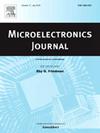High-precision vernier-type optoelectronic integrated chip design
IF 1.9
3区 工程技术
Q3 ENGINEERING, ELECTRICAL & ELECTRONIC
引用次数: 0
Abstract
An optoelectronic integrated chip combining vernier coding and Gray coding is designed in this study. The structure that combines two encoding methods provides a more accurate delineation of the angles. This improves the accuracy of angle measurement. In addition, the chip incorporates a specially shaped photodiode array. It is designed with a special boundary function to filter out odd harmonics. The chip also integrates a fully differential amplifier to reduce common mode noise and filter out even harmonics. Based on the 0.35 μm CMOS process, the chip area is 3.41 mm × 2.91 mm. The measurement shows that the chip can operate normally in the ambient temperature of −40 °C–125 °C. Moreover, the chip can output sinusoidal signals and Gray code signals with good orthogonality and accuracy when the motor speed is within 3000 rpm.
高精度游标型光电集成芯片设计
本研究设计了一种结合游标编码和格雷编码的光电集成芯片。结合两种编码方法的结构能更精确地划分角度。这就提高了角度测量的精确度。此外,该芯片还集成了一个特殊形状的光电二极管阵列。其设计具有特殊的边界功能,可滤除奇次谐波。芯片还集成了一个全差分放大器,以降低共模噪声并滤除偶次谐波。芯片采用 0.35 μm CMOS 工艺,面积为 3.41 mm × 2.91 mm。测量结果表明,该芯片可在 -40 °C-125 °C 的环境温度下正常工作。此外,当电机转速在 3000 rpm 以内时,芯片能输出正弦信号和格雷码信号,且正交性和准确性良好。
本文章由计算机程序翻译,如有差异,请以英文原文为准。
求助全文
约1分钟内获得全文
求助全文
来源期刊

Microelectronics Journal
工程技术-工程:电子与电气
CiteScore
4.00
自引率
27.30%
发文量
222
审稿时长
43 days
期刊介绍:
Published since 1969, the Microelectronics Journal is an international forum for the dissemination of research and applications of microelectronic systems, circuits, and emerging technologies. Papers published in the Microelectronics Journal have undergone peer review to ensure originality, relevance, and timeliness. The journal thus provides a worldwide, regular, and comprehensive update on microelectronic circuits and systems.
The Microelectronics Journal invites papers describing significant research and applications in all of the areas listed below. Comprehensive review/survey papers covering recent developments will also be considered. The Microelectronics Journal covers circuits and systems. This topic includes but is not limited to: Analog, digital, mixed, and RF circuits and related design methodologies; Logic, architectural, and system level synthesis; Testing, design for testability, built-in self-test; Area, power, and thermal analysis and design; Mixed-domain simulation and design; Embedded systems; Non-von Neumann computing and related technologies and circuits; Design and test of high complexity systems integration; SoC, NoC, SIP, and NIP design and test; 3-D integration design and analysis; Emerging device technologies and circuits, such as FinFETs, SETs, spintronics, SFQ, MTJ, etc.
Application aspects such as signal and image processing including circuits for cryptography, sensors, and actuators including sensor networks, reliability and quality issues, and economic models are also welcome.
 求助内容:
求助内容: 应助结果提醒方式:
应助结果提醒方式:


